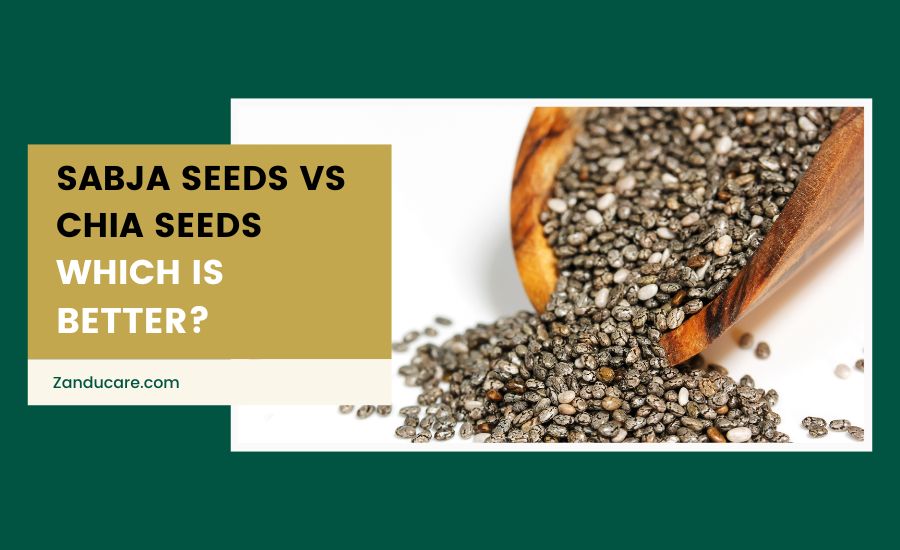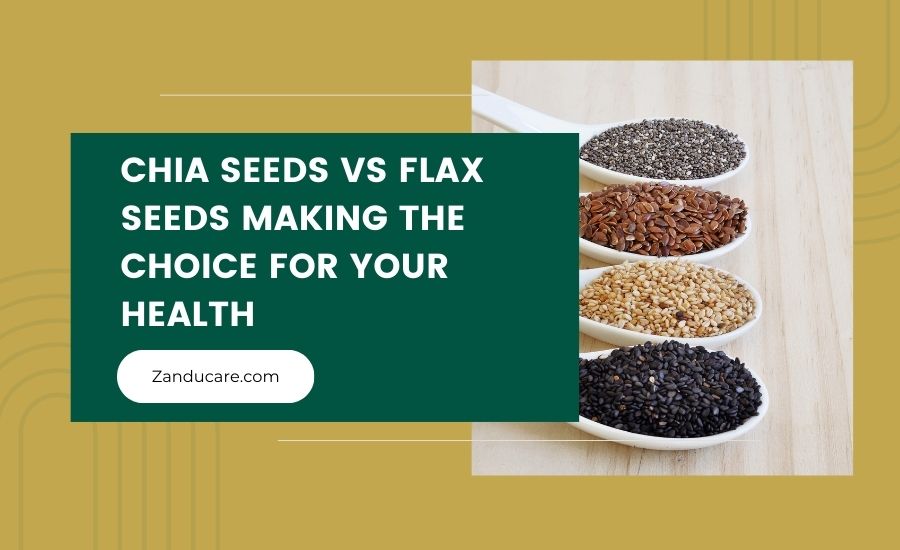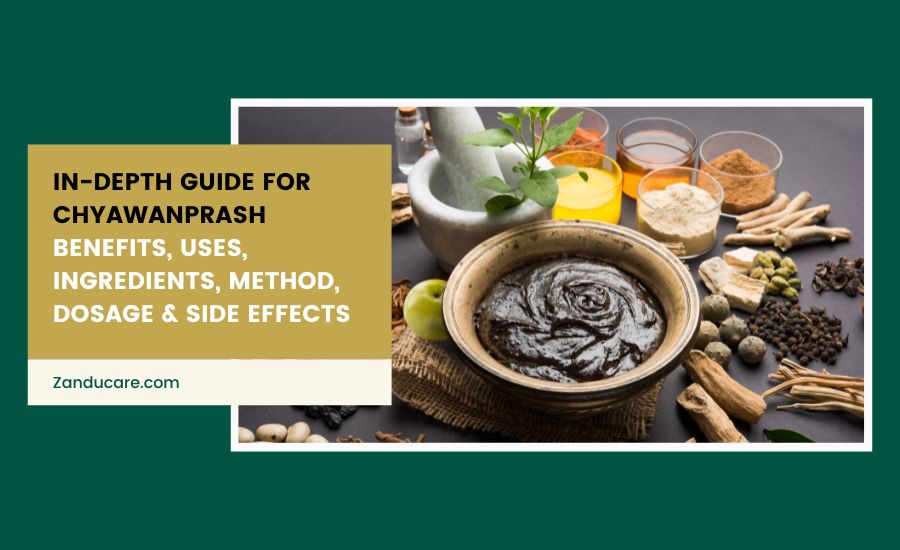
Sabja Seeds vs Chia Seeds: Difference in Uses, Benefits & Nutrients
People's awareness of their health and well-being has grown over time. More and more people are including superfoods in their diets. These are high in nutrients and offer a variety of advantages. Chia and Sabja (Basil) seeds are among the most well-liked superfoods available amid the superfood boom.
Nonetheless, because of their similar appearances, most individuals are unable to distinguish between Chia and Sabja seeds, leading to much confusion.
We will now discuss their health advantages and how to include them in a balanced diet.
|
Did You Know
|
Difference between Sabja seeds vs Chia seeds
|
Aspect |
Chia Seeds |
Sabja Seeds |
|
Scientific Name |
Salvia hispanica |
Ocimum basilicum |
|
Common Names |
Chia seeds |
Basil seeds, Tukmaria seeds |
|
Appearance |
Small, oval-shaped, black or white |
Small, round, black |
|
Origin |
Central and Southern Mexico, Guatemala |
India, Southeast Asia |
|
Taste |
Mild, nutty flavour |
The mild, slightly sweet flavour |
|
Nutritional Content |
High in omega-3 fatty acids, fibre, protein, calcium, antioxidants |
High in fibre, iron, protein, antioxidants, calcium |
|
Water Absorption |
Absorb 10-12 times their weight in water, forming a gel |
Absorb 8-10 times their weight in water, forming a gel |
|
Uses in Food |
Smoothies, yoghurt, puddings, baked goods, salads |
Drinks, desserts, smoothies |
|
Health Benefits |
Heart health, digestion, weight loss, energy boost |
Digestion, cooling body, weight loss |
|
Soaking Time |
30 minutes to 2 hours |
10-15 minutes |
|
Culinary Versatility |
Can be eaten raw, added to a variety of dishes |
Typically soaked before use, it is commonly used in beverages |
|
Shelf Life |
Long shelf life when stored in a cool, dry place |
Shorter shelf life, best used fresh |
|
Allergies and Precautions |
Generally safe, but can cause digestive issues if not taken with enough water |
Generally safe, but can cause choking if not soaked properly |
Overview on Chia seeds

Salvia Hispanica, commonly called chia, is an herbaceous plant in the Lamiaceae family native to southern Mexico and northern Guatemala. It produces several dried indehiscent fruits, often known as seeds.
Chia is now grown in Argentina, Bolivia, Peru, Guatemala, Mexico, Australia, and Colombia. In the sixteenth century, pre-Columbian Indians used chia to increase their strength, vitality, and endurance. Chia seeds are used to extract oil, which is then used in cosmetic products. It's possible that the plant's other components—such as its roots, leaves, and branches—were less frequently employed to treat respiratory illnesses.
Nutritional value of Chia seeds
The value of Chia seeds per 100 grams is as follows: -
|
Nutrients |
Content per 100 grams |
|
Fats |
30.7 g |
|
Water |
5.8 g |
|
Protein |
16.5 g |
|
Carbohydrates |
42.1 g |
|
Energy |
486 kcal |
|
Fibre |
34.4 g |
|
Iron |
7.72 mg |
|
Calcium |
631 mg |
|
Magnesium |
335 mg |
|
Sodium |
16 mg |
|
Potassium |
407 mg |
|
Zinc |
4.58 mg |
|
Manganese |
2.72 mg |
|
Selenium |
55.2 ug |
|
Copper |
0.924 mg |
|
Phosphorus |
860 mg |
|
Vitamin B1 |
0.62 mg |
|
Vitamin B2 |
0.17 mg |
|
Vitamin B3 |
8.82 mg |
|
Vitamin E |
0.5 mg |
|
Vitamin C |
1.6 mg |
Health benefits of Chia seeds
- Reducing blood pressure
- Lowering cholesterol levels
- Supporting digestive health
- Aiding in weight management
- Improves anxiety and depression.
- Helps in controlling diabetes
- Protecting against chronic disease
- Reducing inflammation
Overview on Sabja seeds
Seeds of Sabja or basil are widely used as seasonings. They give meals a distinct flavour. However, did you know that sabba or falooda seeds have a ton of health advantages in addition to being great for seasoning food or starting fresh basil plants? When it comes to nutritional value, these little black seeds, which resemble black sesame seeds, can rival flax and chia seeds.
They are taken from Sweet Basil, not Holy Basil, which is more common in India and is highly prized for strengthening immunity.
Nutritional value of Sabja seeds

This chart of Sabja seeds is per 1 tablespoon or 13 grams
|
Basil Constituents |
Amount |
|
Calories |
60 |
|
Omega-3 fatty acids |
1.240 g |
|
Fats |
2.5 g |
|
Protein |
2 g |
|
Carbohydrates |
7 g |
|
Iron |
10% of daily intake |
|
Magnesium |
10% of daily intake |
|
Calcium |
15% of daily intake |
|
Also contains polyphenols and flavonoids |
Health benefits of Sabja seeds
- Acts as a natural body coolant
- Good for diabetic patients
- Reduces blood sugar levels
- Helps in relieving constipation and acidity
- Aids in weight loss
- Regularises bowel movement
- Prevent the risk of heart diseases
- Powerhouse of minerals
- Infused with anti-inflammatory and anti-carcinogenic properties
- Reduces cholesterol levels
Also check:
Difference in Appearance & Texture
Chia seeds are a mixture of grey, black, white, and occasionally brown seeds; they are never entirely black. Conversely, Sabja seeds have a consistent jet-black colour. Basil seeds are small and round, whilst the former are slightly larger and more oval.
On soaking in water
It takes time for chia seeds to absorb liquid. However, they can absorb more than ten times their own weight, giving them the unusual capacity to gel.
When Sabja seeds are combined with water, they quickly swell. When compared to a wet chia seed, the seed appears significantly more prominent due to the translucent covering that forms around it.
Usage
Chia seeds can be consumed raw or after soaking, while the Sabja seeds can only be consumed after soaking.
Taste of soaked seeds
Chia seeds blend easily into any type of meal and have no distinct flavour. On the other hand, the mild basil flavour of Sabja seeds can be used in desserts and drinks.
Conclusion
In conclusion, Chia seeds and Sabja seeds are both highly nutritious and beneficial, but they have different strengths. Chia seeds are rich in omega-3 fatty acids and have a mild, nutty flavour, making them versatile for various dishes. Sabja seeds, on the other hand, are great for quick hydration, have cooling properties, and are commonly used in drinks and desserts.
Both seeds support digestion and weight loss, but your choice will depend on your specific health goals and culinary preferences. Including either seed in your diet can boost your overall nutrition and wellness.
FAQs
1. Which is best Sabja seeds or chia seeds?
Choosing between Sabja seeds and chia seeds depends on your needs: chia seeds are best for omega-3 and versatility, while Sabja seeds are ideal for quick hydration and cooling properties.
2. Who should not eat Sabja seeds?
Because Sabja seeds tend to raise oestrogen levels in the body, pregnant women should only eat them under a doctor's supervision. Extracts and oil from Sabja seeds can inhibit thrombolysis. Therefore, if you have just undergone surgery or are injured, it is not advised that you consume it.
3. Can Chia and Sabja be taken together?
Yes, consuming both at once can help you lose weight effectively. Soaking them together for fifteen minutes before juicing is the optimal method.
4. Is Sabja good for weight loss?
Sabja seeds are high in protein, good fats, and dietary fibre. They do not contribute to weight gain and are helpful for weight loss. Dietary fibre helps prevent overeating by maintaining a sensation of fullness.
5. Are Sabja seeds good for females?
Sabja seeds are the ideal option for women who experience excessive bleeding during their periods since they lower estrogen levels, which makes them diuretic and very beneficial in treating UTIs.
6. Can we soak Sabja seeds overnight?
Drink a daily solution made by soaking 1-2 tablespoons of Sabja seeds in water for at least 20 minutes.
7. Are there any health benefits of Chia seeds?
Chia seeds might offer a host of health advantages. Diabetes, high blood pressure, heart-related conditions, and obesity might benefit from them. They might also have anti-inflammatory, antioxidant, and anti-cancer qualities. Before consuming chia seeds for any medical ailment, one should, however, always speak with a physician.
8. Does Sabja seeds cause acne?
There isn't any direct evidence that Sabja seeds cause acne. However, due to possible hormonal effects or allergies, excessive ingestion may cause acne in some people. It's recommended to drink them sparingly and pay attention to any individual reactions.
9. What are the side effects of drinking Sabja water daily?
While Sabja seeds have a high fiber content and can help the body digest food better, consuming too many of them can cause unpleasant side effects including diarrhea, bloating, or cramping in the abdomen. It is therefore strongly advised to adhere to the daily usage limit.
References
- Salvia Hispanica, commonly called chia, is an herbaceous plant in the Lamiaceae family native to southern Mexico and northern Guatemala. (https://www.ncbi.nlm.nih.gov/)
- Helps in controlling diabetes. (https://www.researchgate.net/)
- However, did you know that sabba or falooda seeds have a ton of health advantages in addition to being great for seasoning food or starting fresh basil plants? (https://www.ncbi.nlm.nih.gov/)
- Infused with anti-inflammatory and anti-carcinogenic properties. (https://www.ncbi.nlm.nih.gov/)
- Basil seeds, Tukmaria seeds. (https://www.ncbi.nlm.nih.gov/)






